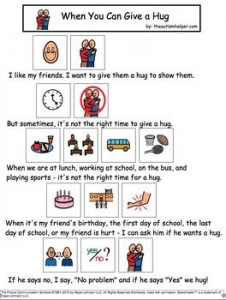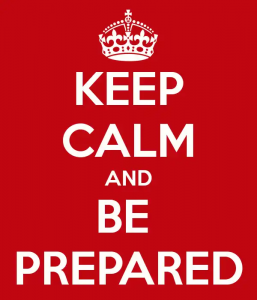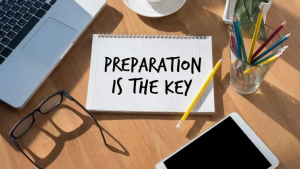Autism Series X: The Power of ‘Preparation’ (Part 1)
Autism Series X: The Power of ‘Preparation’ (Part 1)
The Power of ‘Preparation’ – Preparation is a big part of our lives. We prepare ourselves for our busy days, tasks around the house, sleep time or even work. For individuals with ASD, this aspect becomes essential for them to manage their daily tasks with ease as well as reduced stress and anxiety. Preparation is one of the many ways in which transitions (in routines) or changes (in the environment or behaviors etc.) can be managed better.
What does ‘preparation’ refer to?
‘Preparation’ refers to any means by which individuals are geared towards a schedule/ routine, changes in the routine or even transitions in the environment.
When we prepare ourselves for a simple task, such as an art activity- we would ensure to gather all the essentials (say, craft paper, scissors, pencil, eraser, sharpener), will become mentally prepared for the steps involved in making the craft, and also be geared towards handling any unforeseen disruptions or changes in the plan (for instance the pencil lead breaking, for which we are equipped with the sharpener). The Power of ‘Preparation’
Why is it so essential?
Preparation is considered essential to allow individuals to lead their lives better and function more smoothly in day to day activities. Several individuals with ASD prefer structured routines for this reason. Read more on routines for ASD here.
Being ‘prepared’ for a simple task, such as the cutting activity allows us to be–focused for the task, aware of what needs to be done, able to successfully complete the task and have lesser distractions from it (such as the need to constantly get up for forgotten supplies). This gives an idea of how essential preparation may be for children/individuals with ASD
How to ‘prepare’ effectively for transitions/changes?
It is best to use a combination of visual, verbal and auditory modalities/modes. Here are few ways to prepare an individual effectively for a possible change or transition:
Social stories:
 Stories that have social consequences and information embedded in them are a great way to prepare children who are slightly older or have some basic skills. These stories can be tailor-made to a child’s need and his situation(s) e.g. Prepare a child to wait for his turn at the trampoline or Prepare a child for changes in teachers (transitions) at school.
Stories that have social consequences and information embedded in them are a great way to prepare children who are slightly older or have some basic skills. These stories can be tailor-made to a child’s need and his situation(s) e.g. Prepare a child to wait for his turn at the trampoline or Prepare a child for changes in teachers (transitions) at school.
They can be made very visual (using a lot of photographs or pictures) and colorful, but should not be complicated or too long.
A social story, if read before the possible change or break in the routine, can allow the child to be ready for it and thereby perform better and have lesser stress and discomfort.
You can read more about social stories and how to make them here and here
The Power of ‘Preparation’
Schedule for routine
Having a schedule for routines is crucial. This allows the child to be aware of all the steps or activities (for the day, the session or a specific task). The schedule is often a visual one (pictures, photos, written words, a combination of both) to allow for easy reminders of the tasks.
Such a visual schedule also enabled a child to indicate completed tasks easily. A ‘finish box’ is one of the ways to do so.
Schedules should be placed near the child, or somewhere that is easily accessible. For instance, in the classroom, the schedule may be placed on the child’s desk. At home, it can be on a board that the child passes by often, preferably in his/her work area. Similarly, in a session, it should be in the child’s view at all times (since sessions at typically only an hour long and the child has several tasks to complete through that time).
Read more about routines – here
Several of us schedule our day, by making a to-do list. Doesn’t it make it easier to complete the tasks and know what to expect from the day?
Slowly introduce changes
Changes can be very tough on many children with ASD. Therefore, preparation for it is essential. Making huge changes all of a sudden may not be a good idea. Hence, it is suggested to introduce smaller changes one at a time.
For example, if we have a child who loves to play with cars. Therapists within a session, would not completely remove cars during the initial sessions. They would prepare the child visually about – how the car needs to be kept away, how playing with cars will take turns with playing with blocks, etc.
Changes within our lives and daily routine are inevitable. Therefore we must introduce subtle changes, at times, for our children with ASD. They need to learn to be able to cope with this inevitability.
The Power of ‘Preparation’
Be with your child. Be prepared, yourself.
 This is an important aspect, that may be forgotten several times. When preparation has not been possible and a child may feel overwhelmed – the comfort of a known person can be helpful. At this time – you (the caregiver / familiar therapist) must be prepared on how to handle the situation.
This is an important aspect, that may be forgotten several times. When preparation has not been possible and a child may feel overwhelmed – the comfort of a known person can be helpful. At this time – you (the caregiver / familiar therapist) must be prepared on how to handle the situation.
Allowing the child to calm him/herself in the way suitable for them, continuing to verbally prepare them as you go along, and using short yet assuring words, that you understand their discomfort but they must move on with tasks or the routine.
Each one of us, during our times of discomfort, would like a familiar person around. It is important to remember this for our children too.
Read more about the power of preparation in Part 2 of this article series.
***
Liked the article? Leave a comment, we’d love to hear.
Subscribe to us, to receive the latest articles from 1SP.
***
The Power of ‘Preparation’
- What is speech therapy and what Speech Therapist Do? - December 22, 2022
- 5 Simple Ideas to Make Flashcards Fun - June 28, 2018
- Should I use ‘NO’ with my child? - June 24, 2018


Leave a Comment
(0 Comments)